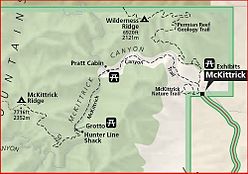McKittrick Canyon
| McKittrick Canyon | |
|---|---|

South McKittrick Canyon from the Notch
|
|

Map of McKittrick Canyon and hiking trails
|
|
| Location | Culberson County, Texas, and Eddy County, New Mexico, United States |
| Floor elevation | 4,997 feet (1,523 m) |
| Long-axis direction | East-West |
| Area | 5,632 acres (2,279 ha) |
| Depth | 3,200 feet (980 m) |
| Geology | |
| Age | 12 million years |
| Geography | |
| Coordinates | 31°58′45″N 104°45′17″W / 31.979167°N 104.754722°WCoordinates: 31°58′45″N 104°45′17″W / 31.979167°N 104.754722°W |
| Topo map | USGS Guadalupe Peak, El Paso Gap |
| Traversed by | McKittrick Canyon Trail |
| Watercourses |
McKittrick Creek |
| Designated | September 26, 1991 |
| Reference no. | 91001381 |
McKittrick Creek
McKittrick Canyon is a scenic canyon within the Guadalupe Mountains of West Texas and Eddy County, New Mexico. The steep towering walls of McKittrick Canyon protect a rich riparian oasis in the midst of the Chihuahuan Desert.
The majority of McKittrick Canyon is part of Guadalupe Mountains National Park but is separated from the main park area and managed as a "day-use only" area with limited visitation hours. However, a large part of North McKittrick Canyon is located in the Guadalupe Ranger District of Lincoln National Forest in New Mexico. Access to McKittrick Canyon is via a 4.2-mile (6.8-km) gated side road that leads to the mouth of McKittrick Canyon from U.S. Route 62/180. Here the National Park Service maintains a parking area, restroom facilities, and visitor center, which is staffed most of the year by volunteers.
McKittrick Canyon Trail begins at the visitor center and initially follows a dry stream, crossing the stream bed several times as it works its way up the canyon. At first the vegetation is more typical of the Chihuahuan Desert with various species of yucca, agave and cacti, such as Spanish Dagger (Yucca faxoniana), Sotol (Dasylirion leiophyllum), Ocotillo (Fouquieria splendens), Lechuguilla (Agave lechuguilla), Century Plants (Agave americana), Prickly Pear (Opuntia spp.) and Claret Cup Cacti (Echinocereus triglochidiatus). Scattered among these desert plants are a few hardy pines, juniper, and the occasional Texas Madrone (Arbutus xalapensis), an unusual tree with red-colored bark that tends to curl-up and peel off each year.
...
Wikipedia
